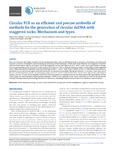Circular PCR as an Efficient and Precise Umbrella of Methods for the Generation of Circular DsDNA With Staggered Nicks: Mechanism and Types

Use this link to cite
http://hdl.handle.net/2183/40607Collections
- Investigación (FCIE) [1259]
Metadata
Show full item recordTitle
Circular PCR as an Efficient and Precise Umbrella of Methods for the Generation of Circular DsDNA With Staggered Nicks: Mechanism and TypesAuthor(s)
Date
2024-08-12Citation
Pedro Ferro-Gallego, Antón Vila-Sanjurjo, Andrea Katherine Valderrama Pereira, Gonzalo Porres Pérez, Lourdes Domínguez-Gerpe, Circular PCR as an efficient and precise umbrella of methods for the generation of circular dsDNA with staggered nicks: Mechanism and types, Biology Methods and Protocols, Volume 9, Issue 1, 2024, bpae051, https://doi.org/10.1093/biomethods/bpae051
Abstract
[Abstract] Here, we introduce the highly versatile circular polymerase chain reaction (CiPCR) technique, propose a mechanism of action, and describe a number of examples demonstrating the versatility of this technique. CiPCR takes place between two fragments of dsDNA with two homologous regions, as long as one of the fragments carries said regions at its 3′- and 5′-ends. Upon hybridization, elongation by a polymerase occurs from all 3′-ends continuously until a 5′-end is reached, leading to stable circular dsDNA with staggered nicks. When both dsDNA fragments carry the homology at their 3′- and 5′-ends (Type I CiPCR), all four 3′-ends effectively prime amplification of the intervening region and CiPCR products can function as template during the reaction. In contrast, when only one of the two dsDNA fragments carries the homologous regions at its 3′- and 5′-ends and the other carries such regions internally (Type II CiPCR), only two 3′-ends can be amplified and CiPCR products possess no template activity. We demonstrate the applicability of both CiPCR types via well-illustrated experimental examples. CiPCR is well adapted to the quick resolution of most of the molecular cloning challenges faced by the biology/biomedicine laboratory, including the generation of insertions, deletions, and mutations.
Keywords
CiPCR
Seamless cloning
Circular-nicked dsDNA
PCR cloning
Site-directed mutagenesis
Ligation independent cloning
Seamless cloning
Circular-nicked dsDNA
PCR cloning
Site-directed mutagenesis
Ligation independent cloning
Editor version
Rights
Atribución 4.0 Internacional
ISSN
2396-8923






